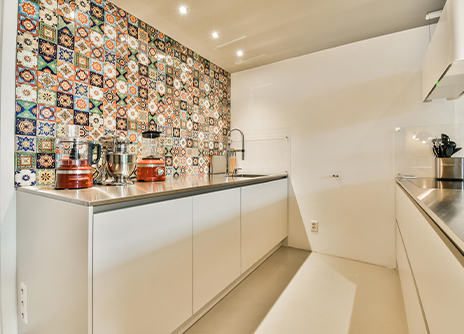
October 28, 2025
Planning kitchen tiles—whether your space is a compact closed kitchen, a semi-open layout, or a full open plan—is equal parts design and damage control. The goal is the same: your kitchen wall tiles and kitchen floor tiles should look stunning day after day while quietly disguising turmeric splashes, oil mist, and tea spills. If you’re hunting for ideas that feel current in 2025 and still make sense for an Indian household, here’s a clear, practical guide—no fluff, just what works.
Start with a simple question: what colour do you want on your walls—beige, brown, or any other trendy colour? Beige keeps the space bright (great for open kitchens) and hides light water marks. Brown brings warmth and masks stains better. For a calm, seamless look, consider running a larger 600×600 mm piece on the wall like Somany’s Valor Arve Beige. If you prefer a compact, grid look with more grout (which can improve grip near the hob niche), the darker Ingrid Dark in 300×300 mm is a stain-friendly base. Both are easy to maintain—handy when cooking is a daily sport.
Practical tip: choose a satin/matt finish (or at least not mirror-gloss) around the hob and sink—it shows fewer water spots and fingerprints. Match grout to the tile tone (beige with warm ivory grout; brown with cocoa/espresso grout) to keep the backsplash visually quiet.
Once your wall colour and finish are set, elevate the kitchen with a statement backsplash. This is where Somany’s Italmarmi Collection shines—luxurious marble-inspired surfaces that instantly add depth, drama, and Italian flair. Use them as:
A vertical highlight behind the hob (creates a focal wall)
A continuous strip across the counter line (adds length and visual flow)
A framed panel between wall cabinets (premium boutique-kitchen vibe)
In open kitchens, the floor is a “view line” from living to dining. Large-format kitchen floor tiles reduce grout lines and make the space look bigger and cleaner—very on-trend for 2025. If you’ve got the room and a good installer, explore slab-like pieces. Somany’s Elan 3.0 Coco Polish (800×3000 mm) delivers a sleek, almost seamless floor and a modern cocoa tone for a warm, contemporary base. Use door mats and runners in wet zones (sink, fridge) and consider a matt finish in heavy-cook homes. Large formats minimise joints and visually expand space—a win in compact Indian layouts too.
Layout & maintenance notes:
Run tiles along the longer dimension of the room to “stretch” it.
Keep grout joints tight (as per your installer’s spec) and seal them—sealed grout resists curry stains better.
If you expect rough use (trolleys, heavy footfall), ask the dealer for higher abrasion resistance options for kitchen floors.
You don’t have to pick only stone for counters. Somany’s Coverstone slabs are increasingly becoming a favourite for modern kitchens—they come in a solid 15mm thickness, are dense, low-maintenance, and available in long, seamless pieces that work beautifully on countertops and even full-height backsplashes. Their engineered strength means better impact resistance than regular tiles, and the designs pair well with steel appliances, wood tones, or neutral living-room palettes—perfect for open kitchens that need visual harmony. Just confirm the edge finish with your fabricator (pencil-round or chamfer) and ensure they use food-safe adhesive with a neat silicone seal at joints for a hygienic, long-lasting fit.
Think of walls, floors, and counter like a thali—each dish distinct, but harmonious together.
If your walls are beige (Valor Arve Beige FP): pair with a mid-tone taupe or cocoa floor (not too dark, to avoid dust halos) and a cool grey counter (Plush Grey) for balance. Beige + grey feels contemporary and keeps the living–kitchen transition smooth.
If your walls are brown (Ingrid Dark): choose a slightly lighter brown/greige floor so the kitchen doesn’t feel heavy. A light grey or off-white counter prevents the scheme from turning too dark.
Two extra rules of thumb:
1. Vary scale—if the floor is large-format, keep the wall tile smaller (or vice versa) to avoid monotony.
2. Control sheen—mix one matt/satin surface with one polished so light scatters softly rather than glaring.
Warm greige & taupe for floors: Warmer neutrals have edged out the cold greys. They’re kinder to dust and connect well with wood furniture in the dining/living space. If you want a trend-safe floor that hides stains, pick a warm greige in a matt or soft polish.
Beige-on-beige for walls (with texture): Beige isn’t boring when you play with texture—think subtle vein, canvas, or fluted effects for backsplashes. Fluted/3D tiles add depth without loud colour; keep them away from the messiest zone or seal the grout well.
Soft greens for accents: Sage and eucalyptus tones bring freshness without stealing attention from the living room. Use them in a small backsplash band, bar back, or open shelves—easy to update later.
Modern greys for countertops: Mid-light greys keep appliances, cookware, and everyday clutter looking organised. A slab like Plush Grey Polish sits comfortably with beige or brown wall tiles.
In an open kitchen, pick colours that sit politely next to your living room: warm greige/taupe for the kitchen floor tiles, beige or soft brown for kitchen wall tiles, and a quiet grey slab for the counter. Keep grout tight and tonal, choose finishes that don’t broadcast every splash, and use large formats where you can for fewer joints. If you prefer tried-and-tested options, Somany Ceramics’ ranges above make it easy to mix durability with a 2025-ready look—so your kitchen tiles stay stylish on day one and practical on day thousand.